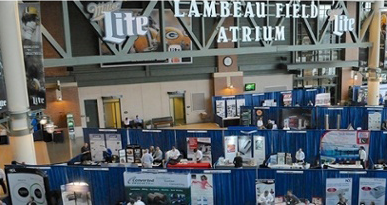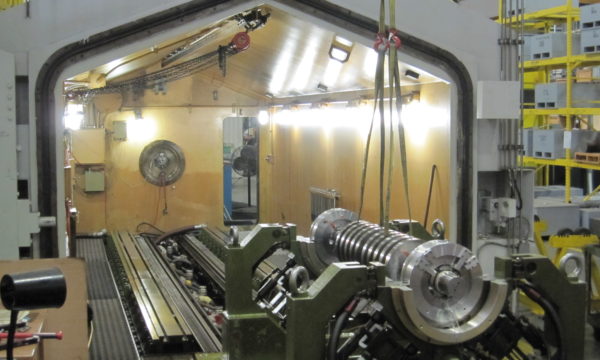Learn How Air Bearings are Overcoming Challenges in the Converter Industry
In our ‘grab-and-go’ society, customers are driving the demand for convenience. As a result, the converting and packaging industry continues to grow, particularly with the boom of flexible packaging. It’s one of the reasons why industry leaders recently gathered at the 2018 Converters Expo as they continue to research solutions to remain innovative in product development as well as manufacturing.
Believe it or not, something as simple as your bearing choice can make a world of difference in your manufacturing productivity and efficiency. Air bearings are replacing traditional ball bearings in the converter industry and beyond as manufacturers reap the benefits gained by removing friction.
Whether your product is paper, film, plastics or non-wovens, the mere presence of friction within your converting manufacturing line causes some of the same challenges, including:
- Speed
- Reliability
- Energy Consumption
- Maintenance
Let’s take a closer look at air bearings and how they are overcoming these challenges of the converting industry.
Air Bearing Design Basics
The main premise of air bearings is to use pressurized air to provide lift and separation between components. The use of air eliminates friction and subsequent wear while also removing the need for oil/lubrication which burden equipment utilizing ball bearings.
There are two primary methods of air distribution.
- Orifice Compensation
Lift is provided by forcing air through one or more hole(s) or grooves.
- Porous Media
Air is delivered through a porous carbon material. The natural permeability of this material offers millions of holes that allow the distribution of air.
The main difference results in the number of holes through which the air is delivered. This has a direct effect on the evenness of the air distribution. When air is delivered through a minimal number of holes, like orifice compensation, pressure gradients develop. If air supply is unexpectedly lost, these pressure gradients may result in damaging contact or contamination. Also, if the bearing becomes scratched near an orifice, the bearing is likely to crash as the volume of air escaping is more than the air supply is providing.
With the use of porous media, the air is evenly distributed. In the event of an air supply loss, a smooth touchdown occurs as the air slowly bleeds out across the millions of holes. This approach alleviates concerns of damage or contamination. Even a scratched porous media surface has been shown to still emit an even distribution across the remaining undamaged holes.
The advantages of even distribution is one of the reasons New Way has chosen to adopt a porous media design for all its air bearing products. Our Porous Media TechnologyTM utilizes a porous carbon material inherent with millions of sub-micron holes. A thin, stiff air film is created across the entire bearing surface providing an even distribution. This even distribution not only eliminates concerns of pressure gradients, but enables improvements in precision and reliability as well.
Air and Thrust Bushings: Air Bearing Solutions for the Converter Industry
Ideal for the converter industry, New Way offers both air bushings and thrust bushings.
Air bushings distribute air through a ‘tube’ of porous media. For example, an air pressure of just 60 psi (0.4 MPa) is distributed evenly through millions of sub-micron holes that occur naturally in the bearing surface, creating an 8 µm (0.0004″) layer of air between the bushing and the shaft.
The bushing is designed so that a self-centering force is created by the air flow, allowing for true 360° non-contact motion on round shafting. The paralleling force over the length of the bushing centers the shaft naturally, creating precise, non-contact motion in one axis.
Available in a range of standard Metric sizes from 13 mm to 75mm, and in English sizes from ¼” to 3.00″, and custom sizes up to 1m in diameter, New Way Air Bushings are designed to fit commonly-available shaft sizes.
Air bushings can be used in rotary or linear applications, though they are often found where both precision linear and rotary motion is required concurrently.
Thrust bushings provide an axial constraint to the air bushing. A porous-media thrust face is added to the air bushing tube. This allows radial motion while constraining one end axially to prevent linear motion in one direction. One of the most-common uses of the thrust bushing is for the creation of custom air spindles.
Available to run on standard English 5/8” and 1-1/4” shafting, New Way Thrust Bushings can also be custom manufactured to your exact size requirements.
The key discriminator of both New Way Thrust Bushings and Air Bushings is through the use of our patented Porous Media TechnologyTM. This unique approach to removing friction creates a cascade effect of benefits well-suited to address the challenges seen by the converting industry.
Five Ways Air Bearings are Improving the Converter Industry
Here are five ways New Way Air Bushings and Thrust Bushings are improving manufacturing to keep pace with consumer demands in the converter industry.
- Decreased Energy CostsNo moving parts mean significantly less energy is required to keep a roll spinning. The ease of rotation imparts improved operational efficiency by reducing the load/stress on drives and motors, translating to a decrease in energy costs.
- Decreased Heat GenerationFriction creates heat and its effects need to be managed so as not to degrade component and machine operations. Heat generation from friction causes degradation of oil/lubrication resulting in wear and hastening the end of product life. Removing friction from the equation means there is less heat generated during operations allowing for increased operation time as well as increased component life.
- Decreased Maintenance DowntimeWith the elimination of friction, downtime caused by wear is drastically reduced. The removal of burdensome oil/lubrication requirements provides an increase in operation time and production. Decreasing heat generation minimizes wear concerns which drive downtime to perform component replacement.
- Increased SpeedHigher speeds can be reached because there is no contact or moving parts as compared to conventional ball bearings. The self-centering force present with air and thrust bushings allow for higher than standard rotational speeds in spindle-type applications. Additionally, thrust-bushing-spindles deliver very low synchronous error motion and virtually zero asynchronous error motion, when compared to rolling-element-bearing spindles.
- Increased ReliabilitySince there are no moving parts or friction-induced wear with air bushing or thrust bushing, reliability increases significantly. Additionally, the evenness of the porous media provides a robust design in the case of air supply loss as the stage or spindle will gradually come to a stop.
Ready to Convert?
Sometimes all it takes is one small change to create a domino effect of positive results.
Sometimes it takes questioning the fundamentals of what you’ve always been doing to conquer the challenges before you.
A change from ball bearings to air bearings could be THE key domino to advance the manufacturing of your product in the converter industry. Whether you are purchasing for new equipment or looking to interchange/retrofit existing bearings, let us help you determine the right air bearing solution for your converting application. Contact us today for a complimentary consultation!



